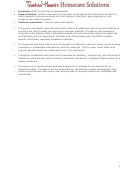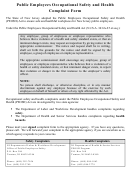OSHA Fire Safety
PREVENTION AND SAFETY
Inspect your client’s home for fire hazards regularly.
Check fire alarms to ensure they are in working order.
Know where fire extinguishers are kept.
Keep combustibles and flammables away from heat.
Keep equipment that can spark away from areas where oxygen is in use.
Know the emergency evacuation plan for your patient. All patients should have an emergency plan in
their charts.
Make sure client’s travel bag is well stocked with essentials.
WHAT TO DO IF A FIRE OCCURS
First: Remember R.A.C.E.
R- Rescue/Remove- Move patient and others away from immediate danger.
A-Alarm: Call 911. You must alert the local fire department. Call RN on call as soon as possible.
C- Confine or contain the fire. Close doors and windows, if able to do so safely.
E- Extinguish the fire if you can safely do it without causing any danger to yourself and others. If the
fire is a very small one that you can quickly and safely put out using water or a fire extinguisher, do it.
If the fire is too big, get everyone out and call the fire department to put the fire out.
In case of emergency, keep a fully stocked travel bag containing everything necessary for the patient.
All personal items should be left behind. No one should go back into the home. Take only what is
needed for the patient.
HOW DO FIRES START
Fire is a chemical reaction involving rapid oxidation or burning of a fuel and needs three elements to
occur- fuel, oxygen and heat (ignition source).
Fuel- can be any combustible material-solid, liquid or gas. Solids and liquids must be heated to a
vapor or gas before they can burn
Oxygen- the air we breathe is about 21% oxygen. Fire only needs an atmosphere of 16% oxygen to
burn.
Heat- heat is the energy necessary to increase the temperature of the fuel to a point where sufficient
vapors are given off for ignition to occur.
Take any one of the three factors away, and the fire cannot occur or will be extinguished if it is
already burning.
Classification of fires
Classified by the types of materials that are burning.
Class A- ordinary combustables or fibrous materials, such as wood, paper, cloth, rubber and some
plastics.
Class B– flammable or combustable liquids such as gasoline, kerosene,paint, paint thinners and
propane.
1
 1
1 2
2 3
3 4
4 5
5








